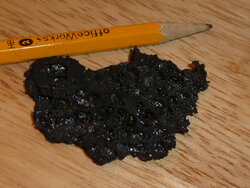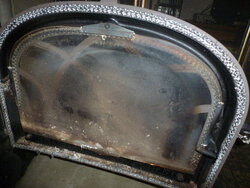I was up on the roof, cleaning the gutter, and saw this in the gutter. I knew immediately what it was, and indeed, there's much more on the underside of the chimney cap. This fragment was part of a 3" x 6" sheet (I tried to light it on fire to see how flammable it was.)

I've been slowly learning about how to operate our two stoves, but it's been hard to break from the habits I formed while burning in open fireplaces. I really do think I am learning my lessons, which are to pack the stove much more than I had been, pay better attention to the air, pay better attention to the room and stove temps and NOT the flame, and then either let it cool down, or pack it again, instead of being throwing a split or two on at a time, poking along.
My questions: should we get it cleaned now, or just finish the season and then get it cleaned? Can I reverse some of this with really hot burns? How bad is this shiny black sheeting, compared, say, to the powdery soot I see coming out of the Morso chimney? Is it possible to "preview" how much creosote is in the flue by using a fiberoptic camera? I have been tempted to buy one on eBay. Thanks in advance, my experienced friends.

I've been slowly learning about how to operate our two stoves, but it's been hard to break from the habits I formed while burning in open fireplaces. I really do think I am learning my lessons, which are to pack the stove much more than I had been, pay better attention to the air, pay better attention to the room and stove temps and NOT the flame, and then either let it cool down, or pack it again, instead of being throwing a split or two on at a time, poking along.
My questions: should we get it cleaned now, or just finish the season and then get it cleaned? Can I reverse some of this with really hot burns? How bad is this shiny black sheeting, compared, say, to the powdery soot I see coming out of the Morso chimney? Is it possible to "preview" how much creosote is in the flue by using a fiberoptic camera? I have been tempted to buy one on eBay. Thanks in advance, my experienced friends.



 and see how it goes.
and see how it goes.